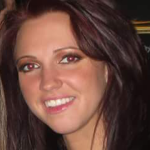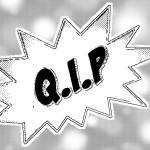
Dr Aarthy Uthayakumar is a retired lacrosse player who now spends her time watching American TV box sets and seeing patients. She has a strong interest in medical education and hopes to specialise in dermatology.

Dr Samantha Greenfield is an English literature graduate turned medic. Currently a prehistoric FY1 at UCLH. She used to file x-rays for a living and continues to have interests in radiology and general medicine.
So the major planning stage had come to an end. Data sources had been identified, interventions envisaged. Attainable project scopes were firmly fenced off from the wilderness of unrealistic expectation by walls of hefty, unmanageable notes, cemented with reams of underfilled blood bottles. Armed with our new QIP understanding, we felt Quite Impressively Prepared; our PDSAs were Perfectly (Demonstrably) Super-Appropriate in our opinion, yes we felt truly SMART…if a little overloaded with acronyms.
 The data gathering had begun, and so had a new phase of learning. This was the practical problem phase (PPP). Though able to take a patient list on MS Word from 0-60 in under 5 seconds, even our technical skillset was challenged by the complexities surrounding the creation of a trust-wide smartphone app. For the notes group, financial restrictions and economical sustainability were to become issues all too reminiscent of budgeting out those med school loans on gel pens and baked beans. Basic things such diplomatic allocation of tasks within the groups and communication between all members in sub-teams soon emerged as challenges in themselves.
The data gathering had begun, and so had a new phase of learning. This was the practical problem phase (PPP). Though able to take a patient list on MS Word from 0-60 in under 5 seconds, even our technical skillset was challenged by the complexities surrounding the creation of a trust-wide smartphone app. For the notes group, financial restrictions and economical sustainability were to become issues all too reminiscent of budgeting out those med school loans on gel pens and baked beans. Basic things such diplomatic allocation of tasks within the groups and communication between all members in sub-teams soon emerged as challenges in themselves.
One of the things we realised early on was that our quality improvement projects were less central to (and more-wholly-external-to) everyone else’s world. Surely as a diligent ward clerk, your job satisfaction is only heightened by additional workload in the name of hypothetical FY1-led quality improvement?! Yes, phlebotomy managers, you may now fulfil your actual purpose in life- the distribution of our illustrious questionnaire to your busy-but-no-doubt-wholly-appreciative staff.
 Yes, the success of our proposed data-gathering and initial interventions would rely at least 99.9% on our abilities to sweet-talk our multidisciplinary team colleagues and key administrative staff. Many were reluctant to engage initially, and the challenge was convincing them to give up their time for a concept that would have no immediate positive impact. Unfortunately for them they were up against expert hasslers. Six months of exposure to acute radiology has given us first hand experience of the benefits of perseverance against all odds, and an XXL helping of enthusiasm to go with it.
Yes, the success of our proposed data-gathering and initial interventions would rely at least 99.9% on our abilities to sweet-talk our multidisciplinary team colleagues and key administrative staff. Many were reluctant to engage initially, and the challenge was convincing them to give up their time for a concept that would have no immediate positive impact. Unfortunately for them they were up against expert hasslers. Six months of exposure to acute radiology has given us first hand experience of the benefits of perseverance against all odds, and an XXL helping of enthusiasm to go with it.
So what if our eagerness for progress resulted in an early help-seeking email to our medical director, detailing the minutiae of our project over several pages? We learnt from it, and will strive for a conciseness more consistent with his succinct reply in future communications! We have been lucky enough to have a lot of senior support, and have so far enlisted the assistance of all needed.
 One of the best things about being an FY1, excluding consultant-funded coffees and 20% off at Nandos, is the camaraderie of it all. There’s something about strutting assertively round this shiny, world-class hospital, while secretly having minimal clue about what you’re doing, that binds you all together. Working with friends has been enjoyable, but where passions run high there will inevitably be conflict. Ever mulled over the impossibility of having lengthy debates with your mates about the structural design of folders with secondary loss of sleep? In our experience this is not only possible, but unavoidable. At such testing times, we have had to work hard as a team to avoid descent into a PMQs-esque verbal fracas. We are all developing our skills in the art of compromise, learning to balance the communication of our own opinions with the importance of listening to others. After a challenging contest so far: Obstacle-itis: 0 vs heroic QIP doctors: 1.
One of the best things about being an FY1, excluding consultant-funded coffees and 20% off at Nandos, is the camaraderie of it all. There’s something about strutting assertively round this shiny, world-class hospital, while secretly having minimal clue about what you’re doing, that binds you all together. Working with friends has been enjoyable, but where passions run high there will inevitably be conflict. Ever mulled over the impossibility of having lengthy debates with your mates about the structural design of folders with secondary loss of sleep? In our experience this is not only possible, but unavoidable. At such testing times, we have had to work hard as a team to avoid descent into a PMQs-esque verbal fracas. We are all developing our skills in the art of compromise, learning to balance the communication of our own opinions with the importance of listening to others. After a challenging contest so far: Obstacle-itis: 0 vs heroic QIP doctors: 1.
The prognosis for our projects looks good, let’s hope the challenges remain surmountable. To be continued…
If you have any ideas or tips to help our FY1 QI team please tweet us with #UCLHQI at @UCLHmeded and @BMJQuality.